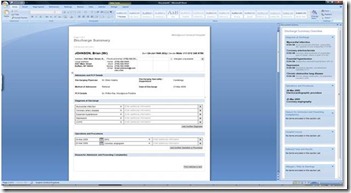Release date for the Clinical Documentation Solution Accelerator
Our team in the UK that is doing the great work on the Clinical Documentation Solution Accelerator (CDSA) for the Microsoft Office System, that we showcased at HIMSS earlier this month have indicated that it will be ready for general release on April 16th. CDSA is the release name for what was previously known as ‘Office Doctor’. ‘Office Doctor’ was showcased at HIMSS 2009 as a technology demonstrator product. This year we are releasing it as a full solution accelerator with guidance and source code that you can use to integrate this functionality in your products or solutions. You can access a video of the 2009 ‘Office Doctor’ here.

Our health specific solution accelerators, as the name indicates help you in two ways:
- The word ‘solution’ refers to the fact that they provide a basic solution or building block that addresses a common problem or challenge in the health domain. They are architected, built and designed using Microsoft and industry best practices and can be integrated and extended to fit your specific solution needs in the same domain scenario. These solution accelerators are available as free downloads along with source code where applicable and documentation.
- ‘accelerator’ means that they will help you accelerate your ramp up or learning experience on how to use our technology to solve the health domain problem(s) that the solution accelerator is meant to address. Since we have considerable engineering work done on these solution accelerators done upfront, they will help you speed time to market of your product or offering if you are a partner or planning and deployment of your solution if you are part of the ICT department in a health organization. Most importantly, for ICT managers and ICT project managers, these solution accelerators will help you better manage risks at different stages of the project lifecycle.
Following is a more detailed description of the CDSA that we will be releasing next month. You will be able to access it from the Health ICT Resource center:
The Clinical Documentation Solution Accelerator (CDSA) for the Microsoft® Office system is a Connected Health Platform resource that enables you or your customer to define and create clinically encoded documents. You originate documents with ready-made templates (for example, for a Discharge Summary or a Referral) retrieved using the Microsoft Office System.
CDSA promotes the safety and consistency of clinical documentation by utilizing Microsoft Health Common User Interface software toolkit components. Those components support the embedding of structured, machine-readable clinical information in a human-readable Microsoft Office document shareable across care boundaries. The encoding of clinical information is to industry standard formats (such as the Health Level 7 (HL7) Clinical Document Architecture (CDA)).
This resource demonstrates the direct utilization of external clinical data (such as a cloud platform or Windows® Azure™ source) in a document. Example external data sources include Systematized Nomenclature of Medicine - Clinical Terms (SNOMED CT®) encoding services or drug reference data. This enables a powerful editing experience, specific to the healthcare domain but easy to use because it offers familiar, industry‑leading authoring tools, such as Microsoft® Office Word 2007 or Microsoft® Office Word 2010.
You can use CDSA as the foundation for clinical document workflows (for example, in combination with Microsoft® Office SharePoint® Server 2010). Tailor those to the specific Electronic Medical Record (EMR) or Electronic Health Record (EHR) systems in your own or your customer’s healthcare environment. In addition, CDSA will enable you to create clinical documents suitable for upload to a Personal Health Record (PHR) system (such as Microsoft® HealthVault™), to an XDS.b system, or to other external storage.
It is easy to share clinical documents created using the CDSA, passing them across care boundaries whilst retaining the clinically encoded data. This is without the need for additional software on your reader’s computer. Systems integrating the CDSA functionality can also take advantage of Microsoft Office Information Rights Management (IRM) capabilities enabled by the Microsoft Windows Rights Management Services (RMS) to control access and usage of confidential health information stored in these documents regardless of where these documents are located.
teddy bachour
senior industry technology strategist, ww health